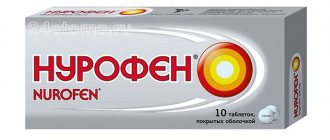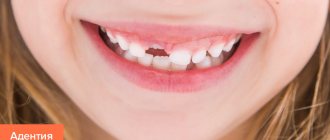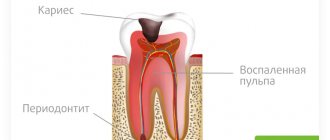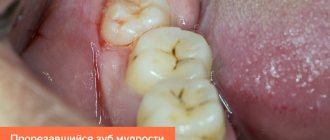One of the most common reasons for patients visiting dental clinics is traumatic damage to teeth and surrounding tissues. At any age, a tooth bruise can occur - a painful injury, which, despite the discomfort, at first looks quite harmless. Subsequently, it often turns out that the pain does not subside, and the bruised tooth begins to react to hot or cold. This usually means that the neurovascular bundle—the dental pulp—is damaged, and a visit to the dental office is necessary.
Even a very careful adult can get a severe bruise to a gum or tooth (for example, by not calculating the movement and hitting himself with a spoon or glass). What can we say about kids who are constantly on the move and often fall, hitting their teeth on various objects. As a result, enamel cracks, root fractures, dislocations and other injuries occur. In the ICD (International Classification of Diseases), chapter 29 is devoted to dental injuries, which describes the consequences of single or multiple mechanical impacts leading to disruption of the integrity of teeth and surrounding tissues.
Main reasons
Dental injuries can occur for various reasons, the most common of which are:
- accidental impact of the jaw on a hard object during a fall or in an accident;
- a blow to the front teeth with a glass, spoon or other utensil (sometimes such blows are so strong that they break off part of the incisor);
- a blow to the teeth with a fist or other blunt object (a professional injury that often occurs among fighters of various martial arts);
- chronic injuries associated with a person’s habits or lifestyle (tendency to bite nails, bite pens, frequent consumption of sunflower seeds, cracking pistachios and other relatively soft nuts with teeth);
- damage during the treatment of adjacent teeth (severe tooth bruising can occur both due to a dentist’s mistake, and due to the anatomical features of the patient, advanced diseases and other factors).
The likelihood of enamel fracture and other traumatic damage to dental tissue increases significantly with poor oral care and dental health. In this case, the enamel becomes more fragile, and the initial stages of caries may develop, significantly weakening the tooth. Timely treatment and proper oral health care significantly reduce the risk of injury to teeth as a result of a blow or other physical impacts.
Symptoms of a tooth bruise
Depending on how long and intensely the tooth hurts after a bruise, one can draw conclusions about the severity of the injury.
Often, immediately after the blow, it seems that the pain gradually subsides and will soon go away completely. However, over time, the discomfort only intensifies, and when pressure is applied to the tooth itself or the gum next to it, the pain can become unbearably strong. In addition to pain, the following symptoms may be observed:
- the gums in the area of the bruised tooth swell, a hematoma or edema appears;
- the tooth may acquire a reddish tint due to blood released into the pulp from ruptured vessels;
- bruising of the front teeth can lead to noticeable loosening of individual incisors (it seems to the person that the tooth does not hold well and may fall out);
- Over time, the crown may noticeably darken due to disruption of the nutrition of dental tissues and the penetration of pollutants into enamel cracks.
Any of the listed symptoms is a serious enough reason to contact a dental clinic as soon as possible. Painful sensations always indicate the presence of damage, which can eventually lead to the loss of a healthy-looking tooth.
Types of headaches
There are several types of headaches with VSD:
- physical stress;
- post-stress, resulting from excessive mental and physical stress; physical stress;
- morning, which is based on congestive disturbances of blood flow in the brain;
- pain caused by oxygen starvation, which appeared while being in a stuffy room.
Most often, with VSD there are 2 types of headaches - tension and migraine. Despite the fact that such a condition is always subjective, it is still possible to describe individual symptoms.
Tooth bruise - what to do?
Please note that it is impossible to determine the severity of the injuries yourself. A complete diagnosis must include an x-ray and a professional examination in a dental office. At home, an experienced dentist can examine the damage and make certain assumptions, but even without the necessary tools, he will not be able to make an accurate diagnosis.
If it is obvious that the tooth bruise is quite serious, self-treatment is unacceptable. To ease the pain, you can apply ice or just a cold object and go to the dentist as quickly as possible. If it looks like the jaw is damaged, it is advisable to fix it with a bandage. It is advisable that someone accompany the victim, since he may lose consciousness on the road.
What you can do yourself
If a toothache suddenly appears, you should:
- apply a cold compress to the cheek on the sore side; heat treatment is contraindicated, as this increases blood circulation and leads to the spread of infection;
- examine your teeth, identify possible food debris, remove them and rinse your mouth with a warm solution and soda;
- take a pain reliever (Ketanov, Diclofenac, Solpadeine);
- Visit your dentist as soon as possible for an x-ray.
Note! Dentists recommend using Nimesil powder to quickly relieve pain.
Photo 2: After a dental examination, the doctor will carry out professional hygiene and sanitation of the oral cavity, after which the dentist will prescribe medications. Source: flickr (Aviel Stankevitch).
Treatment
Oral injuries can vary in nature and severity. No matter how painful a tooth bruise seems, treatment must be carried out in a specialized dental clinic. We at Natadent often encounter such cases. After the initial diagnosis, visual examination, interviewing the patient and collecting anamnesis, an x-ray is taken - this is the only way to clearly determine which tissues are damaged and prescribe the correct treatment.
By studying an x-ray, the doctor can determine what kind of damage the tooth has received (this could be a fracture, dislocation, crack, various deformations and other pathologies).
Only after a correct diagnosis can treatment be prescribed. If a tooth injury has caused serious damage, electrodiagnostics is prescribed - a special procedure that allows you to determine the condition of the pulp, detect hemorrhages and necrotic areas in it. If diagnostic actions show that the damage is not very serious, a set of preventive measures is prescribed, which includes:
- application of compresses;
- use of decoctions for mouth rinsing;
- exclusion from the diet of hot dishes and foods that require chewing; exclusion of this area of the dentition from the chewing process by applying a bandage or protective splint.
- taking anti-inflammatory drugs.
If a more serious tooth injury is diagnosed, treatment may include surgery to the structure of the tooth and surrounding tissue. The sequence of actions is determined by the complexity of the injury, but in most cases includes the following steps:
- ;
- Local anesthesia is performed (or general if complex and painful treatment is involved).
- If the pulp sac is damaged, even if the tooth enamel has retained its structure, the doctor drills a hole in it and removes the nerve.
- The canals and cavity are cleaned, treated and filled, as in conventional caries treatment.
;
;
A tooth bruise is a dangerous injury that can lead to undesirable consequences and complications. Even if pulp removal and filling have been performed, it is advisable that the patient undergo a course of therapeutic treatment, and after some time come for additional examination. Only after this can it be said that the consequences of the injury have been completely eliminated and there will be no complications.
Possible complications
Since bruising of a gum, tooth or other tissues in the oral cavity is always individual, it is impossible to give reliable predictions about recovery and possible complications. It usually takes several visits to the dentist to carry out the necessary examinations and procedures, after which a complete recovery can be established. If you do not approach the treatment process responsibly, you can get the following complications:
- darkening of the enamel (due to the penetration of pollutants through cracks, blood entering the pulp and disruption of the nutrition of dental tissues);
- death of pulp cells and formation of necrotic areas leading to tooth death;
- chronic inflammatory processes (pulpitis and periodontitis) leading to more serious consequences.
Very often, a tooth bruise leads to serious but hidden injuries. The victim may feel minor pain and think that everything will go away soon. However, this is not a reason to avoid qualified medical care. The sooner an examination is carried out in a dental office, the greater the likelihood that all consequences will be eliminated, complications will be avoided and the tooth will be as healthy as possible.
Why do my teeth hurt when I walk?
The appearance of dentalgia when walking can be associated with purulent inflammation directly in the oral cavity or in the maxillary sinus.
The cause of unpleasant sensations can be localized in the upper or lower jaw, dental pulp, or periodontal tissues. To determine the etiology, it is necessary to take an x-ray.
Photo 1: Throbbing pain, which intensifies during movement, very often indicates the accumulation of purulent exudate in the periodontal tissues. In an attempt to find a way out, it compresses the tissue, which causes throbbing pain and it always intensifies while walking with each hit of the heel. Source: flickr (Anton Pro).
Possible causes of dentalgia when walking
- Periodontal tissue disease . These are periodontitis, abscess, phlegmon, pericoronitis, periodontitis, granuloma, cyst, periostitis.
- Diseases of hard and soft dental tissues . This is medium and deep caries, purulent or acute pulpitis.
- Disease of nearby tissues . This is odontogenic, traumatic, bacterial, allergic sinusitis.
Dental causes of pain when running and jumping
When running, the feet come into contact with a hard surface as often as possible, but this happens in such a way that the shock absorption does not allow injury to the limbs or other organs . If a person landed on his heels while jumping or running, this would have unpleasant consequences, and a concussion is the most harmless.
shock absorption while walking or running, .
The slightest movement, not to mention jumping, in case of inflammation of the nerve causes severe pain . Caries or periodontal inflammation respond to movement less painfully, but still unpleasantly.
Diseases that cause tooth pain when running and jumping
- Medium or deep caries is the destruction of hard tooth tissues when they are not treated in a timely manner; the carious process comes too close to the pulp, which reacts to the irritant, which gives rise to dentalgia.
- Pulpitis is an inflammation of the nerve of the tooth, among all dental diseases it ranks first in terms of severity of pain; in case of complications, pus accumulates in the chamber, a chronic process begins and dentalgia gradually subsides, but can again appear while running.
- Periodontitis and periodontitis - these inflammatory diseases very often become a chronic process, since at an early stage they give little expressed pain, a person endures without consulting a doctor, but at this time the inflammation only progresses, the discomfort goes away, but when exposed to any irritant, including I hit my foot while running and the pain comes back immediately.
- Less common causes of pain when running and jumping are granuloma and cyst . These are complications of untreated periodontitis, which initially does not cause concern due to its moderate pain and the person does not go to the dentist. In this case, granulation gradually destroys the soft tissue around the tooth and a so-called granulation sac is formed around it. As with a cyst, this sac puts pressure on the tissue, causing pain.
Accompanying illnesses
In addition to the listed dental diseases, the cause of discomfort while walking, running or jumping can be pathological processes in the maxillary sinus. In this case, pain will be felt in the upper jaw area near the molars . This symptom is very easy to confuse with dentalgia, so other typical manifestations of sinusitis should be considered.
Sinusitis can be acute or chronic, appearing as a result of poor-quality dental treatment or as a complication of acute respiratory viral infection. Of most interest is odontogenic sinusitis that occurs after root canal treatment .
When cleaning the tooth cavity, the dentist may not calculate the depth of the canal and perforation of the bottom of the maxillary sinus occurs . In addition, part of a broken instrument may remain in the cavity, or filling material may get into the maxillary sinus.
Often after this, pathological microorganisms penetrate through the tooth cavity into the sinus, causing inflammation. This is what leads to pain that intensifies while running or jumping , which is very easy to confuse with dental pain.











